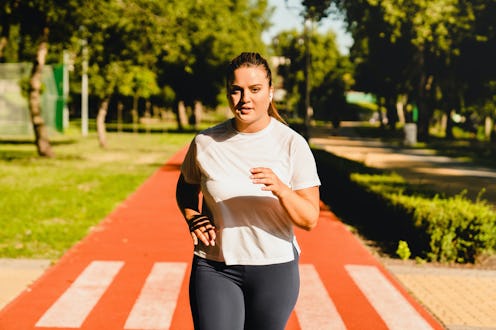Fitness
LISS Workouts Are The Chiller Alternative To HIIT Training
Your guide to the low-intensity way to sweat.

You’ve heard of HIIT, those four letters that mean you’re in for a heart-pounding, high-intensity workout. But you may not have made acquaintance with its cousin, the LISS workout. LISS stands for low-intensity, steady-state and it’s a form of exercise that’s pretty much the opposite of HIIT-flavored burpees, air squats, and flying lunges — or any other type of exercise that spikes your heart rate by going from zero to 100 real quick.
During a LISS workout, you perform a cardiovascular exercise at a lower intensity for an extended period of time, says Hannah Daugherty, a NASM- and ACE-certified personal trainer and health coach. “Activities like cycling, jogging, and swimming can all be LISS workouts, as long as your heart rate doesn’t exceed 70% of the maximum,” she tells Bustle.
The idea is to keep your heart rate elevated without going so hard that you’re completely out of breath. You should be able to maintain your low-intensity movement of choice until the end of the workout, says Daugherty. For the average LISS session, that’ll be anywhere from 30 to 60 minutes, adds certified personal trainer TJ Mentus, which is what gets you into that “steady state.” HIIT workouts are basically the opposite, as they alternate between short bursts of all-out effort followed by brief periods of rest.
“A LISS workout is typically mono structural, too, meaning you use one cardio modality for the duration of the workout,” Mentus explains. Other LISS examples include using an elliptical, rowing, or walking at a faster pace. “Anything that keeps the heart rate in that low-intensity range,” he says. Here, trainers share all the benefits of LISS to know about.
The Benefits Of LISS Workouts
1. It’s Ideal For Active Recovery
In the mood for an easier workout? “LISS is perfect if you want to exercise, but are in a period of active recovery,” Daugherty says. “Since the intensity is lower, this type of training allows your body to heal while you raise your heart rate a bit.”
You can stick with LISS every time you exercise, or pepper it in between more intense workouts to give your body and mind a break. “LISS will speed up the recovery process and allow you to return to higher-intensity training sooner,” Mentus says.
2. It’s Easy On The Joints
Compare rowing or swimming to running or HIIT, and you can see how LISS might be easier on the joints, says Theodore Savage, the senior manager of health and fitness excellence at Planet Fitness gyms. “[LISS workouts] are more low-impact in nature,” he tells Bustle, which is ideal if you want to protect your knees.
3. It Improves Well-Being
Exercise at a steady pace for 30 to 60 minutes, and you might notice that your anxiety and depression symptoms improve, Daugherty says, thanks to all those post-exercise hormones. “The constant movement is great for endorphins, and it gives you a whole hour to step away from life and do something for yourself,” adds certified personal trainer Macy Pruett.
4. It Might Lead To Better Sleep
LISS may be gentle on the body, but that doesn’t mean it isn’t tough. According to Daugherty, a good LISS workout will help you burn off extra energy so that you feel tired enough to sleep. It’s also an ideal evening workout, especially if you don’t want to overdo it before bed.
“Due to the steady-state element, LISS workouts place less stress on the heart and lungs, which reduces the risk of overexertion,” Savage says. “They require shorter recovery times because they are lower in intensity and don’t put as much stress on the muscles.”
5. It Builds Endurance
There’s nothing quite like a long, steady jog to improve your endurance. As health expert Dr. Suzanna Wong tells Bustle, endurance training with longer, slower runs — or swims, or cycles — enables you to practice maintaining movement at a steady pace for a longer period of time. That’s why you might want to use LISS to get ready for a 5K or marathon, she says, or to improve how far you can cycle.
6. It’s A Slower Way To Build Cardio
According to personal trainer Betsy Foster, MS, CSCS, LISS is considered a great form of cardiovascular exercise, even though it isn’t as heart-pounding as classes like kickboxing or cardio dance.
A jog or gentle spin will still raise your heart rate, challenge the cardiovascular system, and improve circulation through steady, prolonged movement, Foster says. Work out for an extended period of time and you’ll notice that you feel more powerful overall — without having to completely gas yourself out.
7. It’s Perfect For Beginners
If other forms of exercise sound too intense, if you’re recovering from an injury, or if you aren’t quite ready to pour sweat, then you may want to hop on the steady-state train. “LISS is a wonderful workout for anyone,” Daugherty says.
Not only is it easier to do lower-intensity workouts, but you can also make LISS your own. As Mentus says, “Just about everyone should be able to maintain a low level of intensity if given the right modality for their workout, even if that means a brisk walk.”
Studies referenced:
Carek, PJ. 2011. Exercise for the treatment of depression and anxiety. Int J Psychiatry Med. 2011;41(1):15-28. doi: 10.2190/PM.41.1.c.
Foster, C. 2015. The Effects of High Intensity Interval Training vs Steady State Training on Aerobic and Anaerobic Capacity. J Sports Sci Med. PMID: 26664271; PMCID: PMC4657417.
Sources:
Hannah Daugherty, personal trainer, health coach
TJ Mentus, personal trainer
Macy Pruett, certified personal trainer
Betsy Foster, MS, CSCS, personal trainer
Theodore Savage, senior manager of health and fitness excellence
Dr. Suzanna Wong, health expert
This article was originally published on